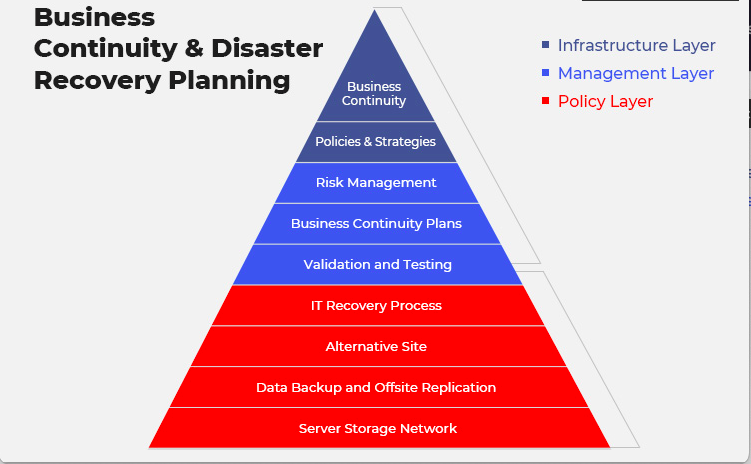Disaster recovery (DR) and business continuity planning (BCP) are two essential components of an organization’s strategy to ensure the continuity of operations and minimize the impact of potential disruptions. While they are related, each has a distinct focus and purpose.

Business Continuity
Business continuity refers to the ability of an organization to maintain essential functions and services during and after a disruptive event. It involves proactive planning and preparation to ensure that critical business processes, people, and systems can continue to operate, or can be quickly restored, to minimize the impact of disruptions.
- Risk Assessment and Business Impact Analysis (BIA): The first step in BC planning is to assess potential risks and their impact on the organization. This includes identifying and analyzing internal and external risks that could disrupt operations, such as natural disasters, technological failures, cyberattacks, or human errors. A business impact analysis (BIA) is conducted to identify critical business functions, their dependencies, and the potential consequences of disruptions. This assessment helps prioritize resources and efforts based on the criticality of different business processes and the associated risks.
- Development of Business Continuity Strategies: Based on the BIA, organizations develop comprehensive BC strategies. These strategies outline the actions, resources, and procedures necessary to maintain essential functions during and after a disruptive event. It includes alternative operating procedures, emergency response protocols, communication plans, resource allocation strategies, and any necessary arrangements with third-party vendors or partners.
- Emergency Response and Crisis Management: BC planning includes establishing emergency response teams and defining their roles and responsibilities during a crisis. These teams are responsible for coordinating response efforts, ensuring employee safety, managing communication with stakeholders (including employees, customers, suppliers, and regulatory authorities), and implementing necessary measures to protect critical assets and data.
- Communication and Stakeholder Management: Effective communication is a crucial element of BC. Organizations need to establish communication protocols and channels to ensure timely and accurate information flow during a disruption. This includes internal communication to keep employees informed, external communication with customers, suppliers, and other stakeholders, and coordination with regulatory authorities. Regular updates and clear instructions help maintain trust and confidence during challenging times.
Disaster Recovery
Disaster recovery focuses specifically on the restoration of IT infrastructure, systems, and data following a disruptive event. The goal of DR is to minimize downtime, recover critical systems and data within defined recovery time objectives (RTOs) and recovery point objectives (RPOs), and ensure the continuity of IT services.
- Risk Assessment and Business Impact Analysis (BIA): Similar to BC, DR planning starts with a risk assessment and BIA. This helps identify potential risks to IT systems and assets, such as hardware failures, software glitches, cyberattacks, or natural disasters. Understanding the potential impact on critical IT components helps prioritize recovery efforts.
- Development of DR Plans and Procedures: Based on the risk assessment, organizations develop comprehensive DR plans and procedures. These plans outline the necessary steps to be taken in the event of a disaster, including backup and recovery strategies, system restoration procedures, communication protocols, and roles and responsibilities for key personnel involved in the recovery process. It also includes considerations for data backup, redundancy, and offsite storage.
- Backup and Recovery Mechanisms: DR planning involves implementing appropriate backup and recovery mechanisms. This includes regular backups of data and systems, utilizing appropriate backup technologies (e.g., tape backups, disk-based backups, or cloud-based backups), and verifying the recoverability of backups through periodic testing. It also involves establishing offsite backup storage or cloud-based backup solutions for redundancy and data protection.
- Testing and Training: Regular testing of DR plans is crucial to ensure their effectiveness. Organizations conduct simulated disaster scenarios, perform recovery drills, and evaluate
Become proactive and implement all these strategies in order to survive in case of any disaster. With improper business continuity and disaster recovery plan, you can experience a big loss. It is necessary for every organization to have long-term business planning.
